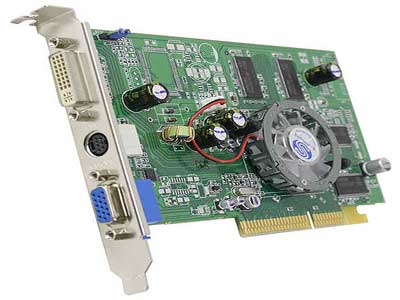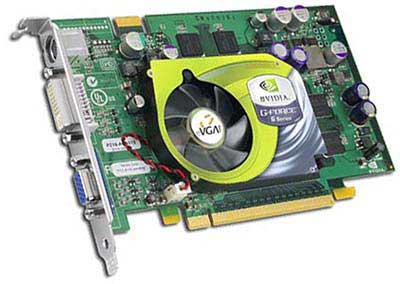Buyer's Guide - Mid-Range, October 2004
by Jarred Walton on October 21, 2004 11:00 AM EST- Posted in
- Guides
Graphics Recommendations
The only typical applications that actually require a decent graphics card are games, but depending on how you plan to use the system, adding a little more power to the graphics subsystem may not be a bad idea. We listed an integrated graphics motherboard as an option for a base Intel system, and that will save you a little money. For the AGP models, a basic Radeon or GeForce will get you by. One of the advantages of purchasing an add-in card is that even the basic models support two displays. This is definitely an advantage for software development and content creation work, where having dozens of windows open at a time is par for the course.Those who are interested in more serious work, like 3D modeling and rendering, might want to look into professional 3D graphics cards, although moderate consumer graphics cards will be sufficient for less serious work. Those looking for an all-around system will also want more than just a basic graphics card. With that said, let's get on to the recommendations.

AGP Recommendation: Sapphire Radeon 9600 Pro 128MB
Price: $108 Shipped (OEM)
At just over $100, the 9600 Pro offers tremendous value. Casual gamers will have more than enough performance for most games, while those interested in content creation or software development get the proven reliability and performance of ATI's drivers. TV Out is also included, for those who might be looking for a Home Theater PC. While it might seem like overkill for anyone who doesn't use any form of 3D graphics, it is hard to recommend anything less than a DirectX 9.0 capable graphics card for any system costing over $1000. Remember that Windows Longhorn - assuming it ships anytime soon - is going to require DX9 support as the bare minimum in order to run. The one option that isn't available for this price is dual DVI output, so those looking at running dual LCD displays might want to find a model that has two DVI ports. While the performance is lower, HIS makes a dual DVI 9600 card that might interest some of you. Downgrading to a stock 9600 or even a 9600SE is also an option if you are sure you don't need the added performance of the 9600 Pro.

Basic PCIe Recommendation: Sapphire Radeon X300 128MB
Price: $85 Shipped (OEM)
PCI Express graphics cards tend to carry a slight price premium, and the X300 is actually comparable to the 9600. The X600 Pro matches the clock speeds of the 9600 Pro, but it costs a little more. For basic computing tasks other than gaming, they will both perform acceptably, so here we go with the slightly cheaper X300. Unfortunately - or fortunately if you're looking for an excuse to upgrade - those looking for dual DVI ports will need to buy a 6600GT card for the time being; specifically, the XFX is one card that includes that option. There are no other PCI Express graphics cards with two DVI ports other than the ultra-expensive X800 XT and Quadro FX1300, which really aren't an option for this price range.

PCIe Alternative: eVGA 6600GT 128MB
Price: $207 Shipped (Retail)
Here, PCI Express has a slight advantage in the price/performance category. The 6600GT includes 8 pixel pipelines, and with a core clock of 500 MHz, it outperforms any AGP card in the same price bracket. ATI's X700 Pro is also available at about the same price and it is similar in features, but comes with 256 MB of GDDR3. The X700XT with 128 MB of RAM and faster clock speeds is also due to show up in retail any time now, but we have not been able to find it there yet. This is really a gaming option, but we would feel remiss if we didn't at least mention it, as the 6600GT is one of the best price/performance graphics cards currently available.
For AGP systems that will be used for moderate amounts of gaming, the only comparable card right now is the 9800 Pro. It's a bit slower in most games and lacks support for SM3.0 but it performs acceptably. The GeForce 6800 is also an option that is slightly faster than the 6600GT and costs a bit more.










54 Comments
View All Comments
Avalon - Friday, October 22, 2004 - link
For the s754 system, to clarify. Sorry. Wish these posts could be edited :)Avalon - Friday, October 22, 2004 - link
If you wanted to cut an additional ~$50, switch out that MSI K8N Neo Platinum and throw in an Epox 8KDA3J. It's only $73 on newegg, shipped, which is within a dollar or two of the Chaintech VNF-250, but has loads more features. After all, you guys gave the 8KDA3+ an editor's choice award, so why not recommend the "value" board in a mid range rig? It's an option to ponder over.dragonballgtz - Thursday, October 21, 2004 - link
A $200 CPU would go better with a 9800Pro IMHO for gamers.JarredWalton - Thursday, October 21, 2004 - link
ksherman, that's basically what I went with, but outside of gaming there is no real need for a fast graphics card. $200 for a graphics card that many people do not want/need is difficult to justify. Rather than create more confusion with talk of gaming alternatives, we are going to look at putting together a Gaming Guide in the near future.The Mid-Range PC is such a broad segment that it is virtually impossible to cover all options without writing a 20,000 word article. This one is already long enough, and that was after I removed the gaming options. Here's the basics, though:
If you want a moderate gaming card for AGP, about the only reasonable choice right now is a 9800 Pro. The 6800/6800GT are too expensive for most people, I think. PCI Express has the 6600GT which tends to be faster than the 9800 Pro by about 10 to 20%. As games are GPU limited in most cases, AMD fans will probably either want to wait for PCI Express motherboards and get a 6600GT, or else bite the bullet and spend $360+ on a 6800GT. Ouch. :)
Beenthere - Thursday, October 21, 2004 - link
Nice guide. Lotta work !!!I think the biggest issue for most folks looking to build a new PC or even to upgrade within a budget, is prioritizing. As you can see from the comments above, gamers always want a top-of-the-line Video card even when this takes a big bite outta the budget. To do that you gotta cut cost some place else and that may compromise the total system performance.
Seems to me that an easy means to quantify and qualify the real options for an individual system would be by listing the hardware categories as you've done on a spreadsheet then plug in the hardware and prices accordingly. I think some folks would be surprised to see how their total system price climbs way beyond their original budget when you add $50. here and there to get the "best" of a particular component or to step up to the next level of component.
As you pointed out, sometimes like with memory, buying the lowest latency modules may cost more than moving up 200 MHz in CPU speed, so the CPU may be a better choice. Your guide and recommendations give PC builders a great head start on getting the most bang-for-their-buck.
Thanks for the effort!
ksherman - Thursday, October 21, 2004 - link
also, I think that a good description for a mid range system should be a system with a good amount of power (hence the processor choice) with out the price premium. I like mid-ranges because they offer the power i need with the versitility to do anything I will need to do for a while down the road.ksherman - Thursday, October 21, 2004 - link
It is kinda weird that you recommend such a low-end card for a mid-range system... to me (as everyone else has stated) the 6600 and 9800's should be in the midrange systems. 9600 and similar should be put into low-end systems... in regards to the x300, you state that it is good for those not into gaming so much as other "basic computing tasks", I think that something like that belongs in the low-end systems category.JarredWalton - Thursday, October 21, 2004 - link
I have made a few minor corrections, and I also added a $1000 AMD 754 system to the summary page, for those that might feel $1250 is too much. :)#3: Corrected, thanks. MB, GB... sometimes my fingers have a mind of their own.
#7: RAID 1 hardware controllers should not incur any noticeable performance penalty, as they simply tell both hard drives to write the same data. Better RAID 1 controllers will actually have improved read performance, as they can pull data from two sources. I have not done any extensive testing of this, however, and would guess that most integrated RAID controllers lack that feature. If anyone knows for sure, speak up.
#12: I didn't put much of an emphasis on gaming, as I hope to cover that more in an upcoming Gaming Guide. We'll see if that gets a green light - it's been a while since we covered that topic in depth, I think, although the Doom 3 craze touched on it.
#15: Stay tuned. That's all I will say for now. The Pioneer is still a good choice, though.
#16: Is that typo corrected now? If not, which page are you seeing that on, since I checked both the Display and Summary pages for the error.
Thanks!
Desslok - Thursday, October 21, 2004 - link
That monitor costs as much as the whole system would?NEC/Mitsubishi FE991SB-BK 19" 1274?????
deathwalker - Thursday, October 21, 2004 - link
Great article...I am a little surprised at the Optical Drive choice of the NEC 3500A @ $73, reason being is that you just reviewed the Pioneer 108 and called it the best drive reviewed to date and its only $78.